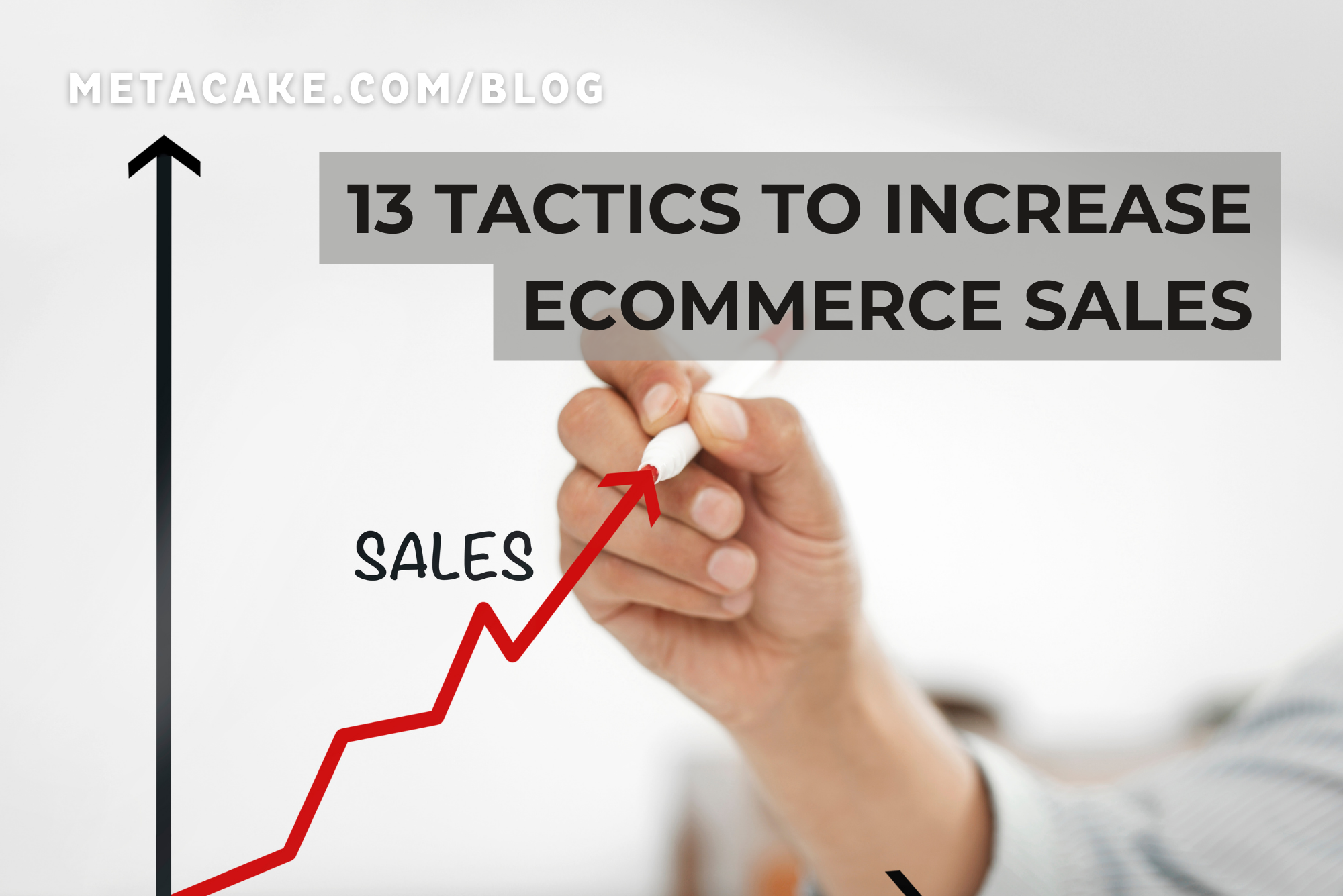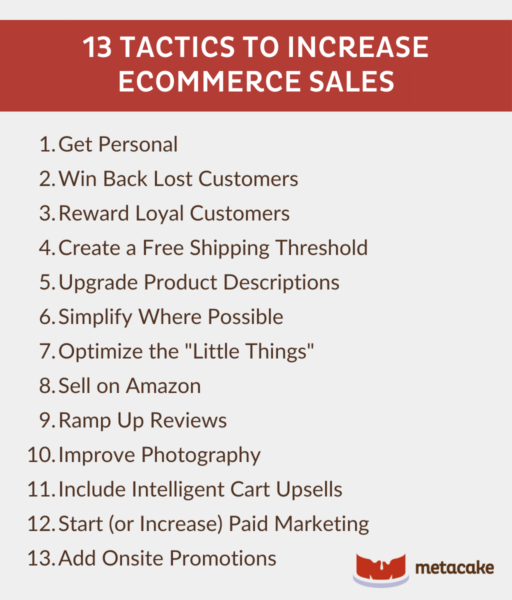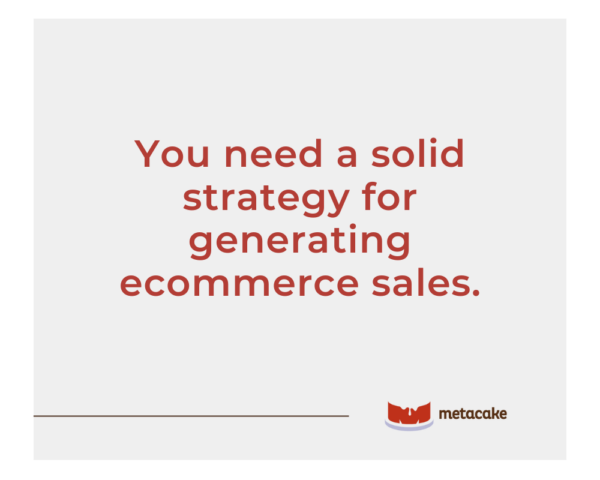
13 Tactics to Increase Ecommerce Sales
So, you’ve checked all the appropriate boxes as an ecommerce business owner. You’ve developed a killer online store, you’re stocked and ready with fantastic products, and now you’re waiting for sales. If you’re wondering where these sales are and how to increase them, you’re not alone.
It’s not only new business owners who feel the absence of sales; business owners at any stage will likely endure this at some point in their ownership odyssey.
While a lack of sales can happen for a number of reasons — some of which are out of our control — we’d like to show you some areas you can work on to increase your ecommerce sales, no matter where you are.

How to Increase Ecommerce Sales
If you thought that sales would naturally start flowing in after you launched your ecommerce business, we invite you to think again. While you’ve accomplished a lot thus far, the journey isn’t over. In fact, the journey is an ongoing pilgrimage.
You need a solid strategy for generating ecommerce sales. And, if you’re a seasoned business owner, you need to be constantly evaluating and refreshing this strategy.
Let’s look at some tactics you can implement to keep your business on track and increase your ecommerce sales.

1. Get Personal
Believe it or not, customers are caring more and more about the story or the reason behind your brand. They want to know a little bit about you and where your company came from. It’s often the only thing that an online shopper can use to differentiate you from the next guy.
If there’s no compelling reason behind why you created your product or your business, customers are not as motivated to buy from you and will likely look elsewhere.
Revealing a little bit about your brand and where your product came from also helps to build trust. Customers don’t want to buy from a faceless company. This is especially important if you’re a new or unknown brand.
According to Stackla, 88% of consumers say that authenticity is a key factor when deciding what brands they like and support.
Make sure to feature this authentic “about you” content on your site. Don’t just hide it in a footer link.
2. Win Back Lost Customers
Follow up with customers who’ve abandoned their cart — and not just once. We recommend setting up a series of three follow-up emails to try to close the sale, the first just an hour after the cart’s abandoned.
If the customer still hasn’t purchased, follow up again after 24 hours with a promotion to push them over the edge.
And if they still haven’t purchased? Remind them just once more, three days later.
There’re plenty of tools out there to help you set up these automated emails. We like Conversio.
3. Reward Loyal Customers
Make sure your current customers are feeling the love. Provide discounts to your loyal customers (either through a loyalty program or regular discounts). This’ll encourage them to continue purchasing.
We also recommend giving them discounts to share with their friends (even if you don’t have a formal referral program).
4. Create a Free Shipping Threshold
Customers expect a free shipping option these days. It’s the price of staying competitive in today’s ecommerce world.
But that doesn’t mean you have to offer free shipping to everyone, no matter what their basket size. Instead, set a threshold for free shipping. Not only does this keep costs down on the shipping side for you, but if you set the threshold intelligently, it can help greatly increase your average order value.
Start by setting a free shipping threshold that’s about 20% higher than your current AOV. Then test and optimize this threshold over time to see what the sweet spot is for your customers.
5. Upgrade Product Descriptions
There’s an art to writing product descriptions. Unfortunately, many people underestimate the importance of product descriptions and devote little work to them.
Don’t be one of these people. Make sure your product descriptions are intentional. The idea is not to make them overly functional. Make sure your descriptions focus on the advantages of your product (how it will improve your customers’ lives) rather than merely the technical details of its characteristics.
At the same time, avoid being overly verbose. Be concise. You want your product descriptions to be easy to understand and not overwhelming.
6. Simplify Where Possible
Remove all waste from the customer’s path. What kind of waste are we talking about? Well, that would be anything along a customer’s journey through your site that isn’t essential (and most likely serves as a distraction from the goal you want your site visitors to accomplish).
This is especially important for stores that’ve been around for a while. Over time, sites become crowded with too much content. You add homepage section after homepage section, feature after feature, product category after product category, and in the end, you’re bombarding your site visitors with too much.
Obviously, you need quality content, but take a hard look at your site and revisit each page to see if there are places you could trim down. Everything that remains should be relevant and valuable to the customer journey.
Less is more.
Not sure where to start? First, take a look at your homepage, product organization, social sharing plugins, animations, and design elements in the cart and checkout pages (which should be particularly clean and simple).
7. Optimize the “Little Things”
Here we’re talking about page titles, meta descriptions, and URLs. These fundamental SEO and usability principles will help you in the long run and are low-hanging fruit.
Create effective page titles that are easy to read and contain the appropriate keywords. Make sure the URL structure for your products is optimized and you have meta descriptions for all your products.
8. Sell on Amazon
Selling on Amazon could prove challenging to set up. Despite the difficulty of setup, Amazon is a valuable supplementary sales channel that can help your business get discovered.
You gain exposure to a far larger number of customers than you would otherwise (for example, people who try to buy everything on Amazon).
Now, there’s a risk of being overly reliant on Amazon. However, as long as Amazon doesn’t account for the majority of your sales, the benefits of expanding into this channel far exceed the risks.
9. Ramp Up Reviews
Social proof sells like nothing else. Not only are reviews one of the most impactful trust-building elements you can have on your site, they’re also one of the single biggest drivers of sales.
So make sure that you’re requesting verified reviews from all your customers soon after they receive your products.
Check out this list of ecommerce tools for some review platforms that make this process a breeze!
10. Improve Photography
There’s one intractable problem with ecommerce. Customers lack the ability to physically experience the item they intend to purchase. That’s why ecommerce requires so many trust-building aspects to persuade new customers to buy from you.
Without outstanding photography, you’ll find it far more difficult to persuade your customers to make a purchase. Since they can’t touch the product, do your buyers a favor and provide excellent product pictures.
And don’t just photograph your products alone. Take lifestyle shots of your product in action so customers can visualize what it’ll be like when they receive it, and include them throughout your site. It’s important to provide this context in order to create an emotional connection and close the sale.
11. Include Intelligent Cart Upsells
If done correctly, offering an upsell in the cart can significantly improve your average order value. The key is to intelligently suggest appropriate complements to the products already in a customer’s cart.
If you’re just offering the same product to everyone who passes through your store, upsells can actually work against you, distracting customers from completing the purchase with an unattractive offer.
12. Start (or Increase) Paid Marketing
Paid marketing is the formula for success for many businesses. Take a look at targeted social media ads and Google Shopping ads to increase your traffic (with the right people) and conversions.
It’s difficult to implement a paid marketing campaign in a single day, but you can get started right away. At the very least, jump on Facebook and consider boosting a post. As you develop great advertising and messaging, you can gradually transition to Facebook ads and other platforms.
13. Add Onsite Promotions
Last, but not least, run promotions on your site! Discounts are a great way to convert customers. Make them an offer they can’t refuse.
Contrary to popular belief, discounting your products doesn’t equate to discounting your brand. You should have a healthy and full promotional calendar.
We like the GetSiteControl tool for performing onsite promotions. It’s a simple way to send promotions via pop-ups and notifications throughout your website.
Final Thoughts on How to Increase Ecommerce Sales
In essence, sales drive the revenue of ecommerce businesses, enabling them to grow, innovate, and compete in the global market. Therefore, it’s imperative that ecommerce business owners understand how to increase these sales.
So, are you ready to put your sales-boosting tools to work? Don’t fret if you’re not there just yet. We have an amazing team of specialists who are eager to help you along the path to increasing ecommerce sales for your business.
Give us a shout! We’re happy to hear from you.
What sales-boosting tips do you have? Leave a comment to let us know!



